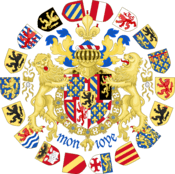Hook and Cod wars
The Hook and Cod wars (Dutch: Hoekse en Kabeljauwse twisten) comprise a series of wars and battles in the County of Holland between 1350 and 1490. Most of these wars were fought over the title of count of Holland, but some have argued that the underlying reason was because of the power struggle of the bourgeois in the cities against the ruling nobility.
| Hook and Cod wars | |||||||
|---|---|---|---|---|---|---|---|
.svg.png) | |||||||
| |||||||
| Belligerents | |||||||
| Hook league | Cod league | ||||||
The Cod faction generally consisted of the more progressive cities of Holland. The Hook faction consisted for a large part of the conservative noblemen.
The origin of the name "Cod" is uncertain, but is most likely a case of reappropriation. Perhaps it derives from the arms of Bavaria, that look like the scales of a fish. The Hook refers to the hooked stick that is used to catch cod. Another possible explanation is that as a cod grows it tends to eat more, growing even bigger and eating even more, thus encapsulating how the noblemen perhaps saw the expanding middle classes of the time.
Margaret of Bavaria vs William V
After count William IV was killed in 1345, his sister Margaret inherited the county. She was married to Emperor Louis IV and resided in Bavaria. She appointed their second son William (the later count William V) as her representative.
In 1350, the nobles of Holland asked Margaret to return to Holland. As a reaction, the Cod league was formed on May 23, 1350 by a number of supporters of William. On September 5 of the same year, the Hook league was formed. Soon afterward, these factions clashed, and a civil war began.
Edward III of England, husband of Margaret's sister Philippa, came to her aid, winning a naval engagement off Veere in 1351. A few weeks later the Hooks and their English allies were defeated by William and the Cods at the Battle of Vlaardingen, which ruined Margaret's cause. Edward shortly afterwards changed sides, and the empress saw herself compelled (1354) to come to an understanding with her son, he being recognized as count of Holland and Zeeland, she of Hainaut. Margaret died two years later, leaving William in possession of the entire Holland-Hainaut inheritance (July 1356). William was married to Maud of Lancaster, sister to Blanche of Lancaster.
Jacqueline of Bavaria vs Philip of Burgundy
Although there were a number of smaller fights in the period after 1356, the main battle re-emerged at the death of William VI, Count of Holland and Hainaut in 1417. Both William's brother John and his daughter Jacqueline claimed the county. The Cods chose the side of John, and, after his death, of Philip the Good, Duke of Burgundy, while the Hooks supported Jacqueline.
The result of these battles and especially of her defeat at the Battle of Brouwershaven, was that Jacqueline was allowed to retain the titles of countess of Hainaut and Holland, but that Philip would rule the county. Philip was named heir to the county, and Jacqueline, who was childless, was not allowed to remarry without Philip's consent.
The treaty became void when Jacqueline remarried in 1432 with Frank van Borssele, and she had to hand her territories over to Burgundy.
The Bishopric of Utrecht vs Burgundy
The period between 1430 and 1450 remained reasonably calm, but when Philip the Good tried to expand his influence into the Bishopric of Utrecht by appointing his natural son David of Burgundy as Bishop, Hook resistance re-emerged in Utrecht. This led to the Siege of Deventer (1456), and two civil wars, (1470-1474) and (1481-1483), concluded in favor of the Cods and Burgundy after the Battle of Westbroek and the Siege of Utrecht (1483).
Frans van Brederode vs Maximilian of Austria
When the House of Burgundy had died out with the death of Mary of Burgundy in 1482, the Hooks revolted one more time against her husband and successor Maximilian I, Holy Roman Emperor. The revolt was led by Frans van Brederode, but crushed in 1490.[1]
See also
- Counts of Hainaut family tree
References
- "Archived copy". Archived from the original on 2013-12-27. Retrieved 2013-12-26.CS1 maint: archived copy as title (link)
